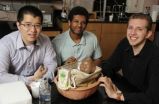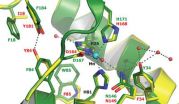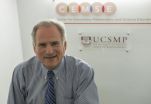(Press-News.org) Dartmouth researchers have taken an important step in the ongoing battle against secondhand tobacco smoke. They have pioneered the development of a breakthrough device that can immediately detect the presence of secondhand smoke and even third-hand smoke.
Smaller and lighter than a cellphone and about the size of a Matchbox car, the device uses polymer films to collect and measure nicotine in the air. A sensor chip then records the data on an SD memory card. The technology is described in a new study appearing in the journal Nicotine and Tobacco Research.
"We have developed the first ever tobacco smoke sensor that is sufficiently sensitive to measure secondhand smoke and record its presence in real time," says Professor of Chemistry Joseph BelBruno, whose Dartmouth lab conducted the research. "This is a leap forward in secondhand smoke exposure detection technology and can be considered the first step in reducing the risk of health effects."
The U.S. Environmental Protection Agency says children are especially vulnerable to environmental tobacco smoke. Its effects on the young can include an increased risk of pneumonia, bronchitis, asthma, and Sudden Infant Death Syndrome. While many parents try not to smoke around their children, going to a different room or smoking out on the porch may not be going far enough. Now, for the first time, there is a prototype sensor that will let the parent see whether or not their precautions make a difference.
"The intent of the project isn't to make them stop smoking, but it is to make them stop exposing their children to smoke. On the other hand, if they are worried about their children, demonstrating these exposures may be an incentive for them to stop," BelBruno says.
Secondhand smoke comes from the burning end of a cigarette or from smoke exhaled by the smoker. Third-hand smoke, also a potential health hazard, according to the Mayo Clinic, is nicotine residue that remains on clothing, furniture, car seats, and other material after the air has cleared.
While the current device is a patent-pending prototype, BelBruno foresees the eventual availability of an affordable consumer version that will incorporate a computer processor, reusable polymer films, and a rechargeable battery. It may even incorporate an LED panel to provide instantaneous readouts.
In addition to its uses in safeguarding childhood health, there are commercial applications for these unique detectors. Installed in rental cars, hotel rooms, and restaurants, this device could help enforce owner and operator smoking bans through an alert system, much like existing, ceiling-mounted smoke detectors.
Before the secondhand smoke project, BelBruno's lab had been working on sensor development for problem molecules such as heavy metals and other toxins in the water and the air. BelBruno says that David Kotz, the Champion International Professor of Computer Science, was the catalyst for the secondhand smoke project.
"He knew that people at the Geisel School of Medicine at Dartmouth were interested in doing a study to try to reduce children's exposure to secondhand smoke, and he knew that we were working on sensors. He got us together, we talked, and this project came out of it."
Given the hundreds of compounds in cigarette smoke, BelBruno's group began with a plan for a multi-component sensor but found this approach unnecessarily complex. The sensor they came up with detects cigarette smoke alone, simply and efficiently.
The research team included Dartmouth chemistry graduate students Yuan Liu and Sadik Antwi-Boampong, and from the Geisel School of Medicine, Mardi Crane-Godreau (Department of Microbiology and Immunology) and Susanne Tanski (Department of Pediatrics and the Dartmouth-Hitchcock Norris Cotton Cancer Center). Crane tested the device in a laboratory smoking chamber and Tanski plans to start clinical studies this summer.
INFORMATION:
This research was supported by the American Academy of Pediatrics Julius B. Richmond Center of Excellence, funded through the Flight Attendants Medical Research Institute, and by the Norris Cotton Cancer Center at Dartmouth-Hitchcock Medical Center.
Scientists create new tools for battling secondhand smoke
2013-03-22
ELSE PRESS RELEASES FROM THIS DATE:
Study offers new way to discover HIV vaccine targets
2013-03-22
Decades of research and three large-scale clinical trials have so far failed to yield an effective HIV vaccine, in large part because the virus evolves so rapidly that it can evade any vaccine-induced immune response.
Researchers from the Ragon Institute of MGH, MIT and Harvard University have now developed a new approach to vaccine design that may allow them to cut off those evolutionary escape routes. The researchers have developed and experimentally validated a computational method that can analyze viral protein sequences to determine how well different viral strains ...
Banning food ads targeted at kids
2013-03-22
Researchers from the University of Alberta are leading a charge among Canada's obesity experts and calling on the federal government to ban food and beverage ads that target children.
Kim Raine, a professor with the Centre for Health Promotion Studies in the School of Public Health at the U of A, says governments need to take action to stem the rising obesity epidemic. The only exception to a proposed food and beverage marketing ban would be for approved public health campaigns that promote healthy eating.
"Restricting marketing is not going to be a cure for childhood ...
Enzymes allow DNA to swap information with exotic molecules
2013-03-22
The discovery of the Rosetta Stone resolved a longstanding puzzle, permitting the translation of Egyptian hieroglyphs into Ancient Greek.
John Chaput, a researcher at Arizona State University's Biodesign Institute has been hunting for a biological Rosetta Stone—an enzyme allowing DNA's 4-letter language to be written into a simpler (and potentially more ancient) molecule that may have existed as a genetic pathway to DNA and RNA in the prebiotic world.
Research results, which recently appeared in the Journal of the American Chemical Society, demonstrate that DNA sequences ...
Breakthrough could lead to cheaper, more sustainable chemical production
2013-03-22
PROVIDENCE, R.I. [Brown University] — A key advance, newly reported by chemists from Brown and Yale Universities, could lead to a cheaper and more sustainable way to make acrylate, an important commodity chemical used to make materials from polyester fabrics to diapers.
Chemical companies churn out billions of tons of acrylate each year, usually by heating propylene, a compound derived from crude oil. "What we're interested in is enhancing both the economics and the sustainability of how acrylate is made," said Wesley Bernskoetter, assistant professor of chemistry at ...
Low-cost 'cooling cure' would avert brain damage in oxygen-starved babies
2013-03-22
When babies are deprived of oxygen before birth, brain damage and disorders such as cerebral palsy can occur. Extended cooling can prevent brain injuries, but this treatment is not always available in developing nations where advanced medical care is scarce. To address this need, Johns Hopkins undergraduates have devised a low-tech $40 unit to provide protective cooling in the absence of modern hospital equipment that can cost $12,000.
The device, called the Cooling Cure, aims to lower a newborn's temperature by about 6 degrees F for three days, a treatment that has been ...
UF fossil bird study on extinction patterns could help today's conservation efforts
2013-03-22
GAINESVILLE, Fla. — A new University of Florida study of nearly 5,000 Haiti bird fossils shows contrary to a commonly held theory, human arrival 6,000 years ago didn't cause the island's birds to die simultaneously.
Although many birds perished or became displaced during a mass extinction event following the first arrival of humans to the Caribbean islands, fossil evidence shows some species were more resilient than others. The research provides range and dispersal patterns from A.D. 600 to 1600 that may be used to create conservation plans for tropical mountainous regions, ...
Scientists reveal quirky feature of Lyme disease bacteria
2013-03-22
Scientists have confirmed that the pathogen that causes Lyme Disease—unlike any other known organism—can exist without iron, a metal that all other life needs to make proteins and enzymes. Instead of iron, the bacteria substitute manganese to make an essential enzyme, thus eluding immune system defenses that protect the body by starving pathogens of iron.
To cause disease, Borrelia burgdorferi requires unusually high levels of manganese, scientists at Johns Hopkins University (JHU), Woods Hole Oceanographic Institution (WHOI), and the University of Texas reported. Their ...
New ASTRO white paper recommends peer review to increase quality assurance and safety
2013-03-22
The American Society for Radiation Oncology (ASTRO) has issued a new white paper, "Enhancing the role of case-oriented peer review to improve quality and safety in radiation oncology: Executive Summary," that recommends increased peer review within the radiation therapy treatment process and among members of the radiation oncology team in order to increase quality assurance and safety, according to the manuscript published as an article in press online in Practical Radiation Oncology (PRO), the official clinical practice journal of ASTRO. The executive summary and supplemental ...
Prescription for double-dose algebra proves effective
2013-03-22
Martin Gartzman sat in his dentist's waiting room last fall when he read a study in Education Next that nearly brought him to tears.
A decade ago, in his former position as chief math and science officer for Chicago Public Schools, Gartzman spearheaded an attempt to decrease ninth-grade algebra failure rates, an issue he calls "an incredibly vexing problem." His idea was to provide extra time for struggling students by having them take two consecutive periods of algebra.
Gartzman had been under the impression that the double-dose algebra program he had instituted had ...
Research explores links between physical and emotional pain relief
2013-03-22
Though we all desire relief -- from stress, work, or pain -- little is known about the specific emotions underlying relief. New research from the Association for Psychological Science explores the psychological mechanisms associated with relief that occurs after the removal of pain, also known as pain offset relief.
This new research shows that healthy individuals and individuals with a history of self-harm display similar levels of relief when pain is removed, which suggests that pain offset relief may be a natural mechanism that helps us to regulate our emotions.
Feeling ...




